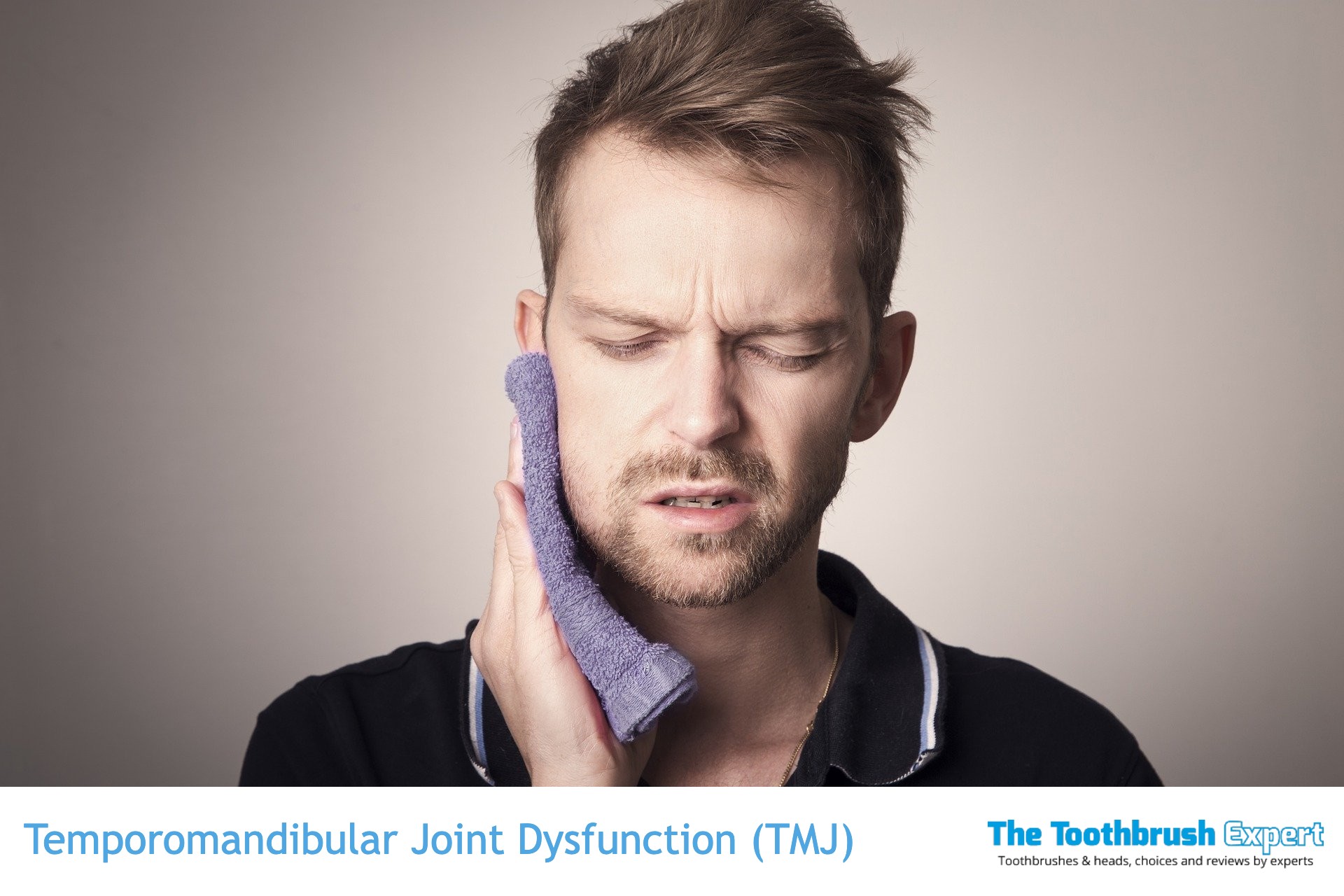To be able to speak and eat, some joints are attached to the lower jaws and are connected to the skull. These joints assist with the movement of the jaw. They are right in front of your ears and extend slightly below them.
Without the joints, it becomes impossible to open and close the jaws with ease. Temporomandibular joint dysfunction refers to a condition that renders those joints tender and weak. Thus, it becomes difficult to move.
All medical content on this site, including this guide and other product reviews, is written by our team of experienced writers and researchers. All writers from The Toothbrush Expert are recommended and reviewed in the industry. You support us through our editorially chosen links, which earn us commission. Learn more
All of our picks have the American Dental Association (ADA) Seal of Acceptance.
What is Temporomandibular Joint Dysfunction?
It is a disorder that affects the jaw movement and its surroundings, making movements like speaking and eating difficult. However, we are all prone to experiencing short-term pain around our jaws and associated muscles at some point in our lives. This temporary pain doesn’t necessarily indicate that the temporomandibular joints are suffering from any dysfunction.
Patients with this disorder experience long-term pain and aches, not just around their lower jawlines. Headaches and earaches are common side effects, and they can be excruciating. Over ten million Americans experience a form of temporomandibular joint dysfunction currently, and this number is projected to keep rising.
This disorder primarily affects women rather than men. In their study, the National Institute of Health discovered that women aged 35 and up have more pain in their masseter muscle and temporomandibular joints than the other genders. This prevalence is even higher in women within their pregnancy years.
Furthermore, the institute has been able to link this with differences in hormonal and anatomical differences between men and women. Nursing mothers or women who use oral contraceptives are even more at risk of this dysfunction.
How it Works
Just as mentioned above, the temporomandibular joint moves the mouth seamlessly around. It is responsible for basic human actions and reflexes like yawning, swallowing, speaking, and chewing. Distinctively, this joint is related only to the mandible, which is the lower jaw.
For actions such as yawning, speaking, or just opening the mouth in amazement, the condyles slide over the joint socket of the temporal bone to make the actions happen. The condyles are the rounded edges of the lower jaw, and when they slide back to their normal positions, that is when the mouth closes. Regardless of how much the mouth opens or closes, the teeth will have to shift and return to their original position.
Causes and Symptoms of TMJ Pain
Aside from the hormonal and biological makeup of women that makes them more susceptible to suffering from TMJ pain, tracking down the real causes and factors responsible for this pain is quite difficult. This is because experts have come to realize that even normal jaw strain and pain are similar to TMJ pain.
The clicking sound in the jaw and jaw-dropping are perfectly normal and more common in some people. This does not imply that such people have a TMJ disorder. It is only when such clicks and dropping become too consistent that it might pose a TMJ problem.
Another reason why TMJ pains are difficult to diagnose is the possibility that a person has a painless TMJ disorder. Nonetheless, here are some of the associated factors and causes of this disorder:
- Bruxism caused by sleep
- Stress and anxiety
- Excessive gum chewing (This puts pressure on the temporomandibular joints and may result in pain.)
- Misaligned teeth (Also known as Malocclusion)
- Rheumatoid arthritis (This is a severe joint condition that may leave joints inflamed and very painful)
After a while, it is common for patients to experience detectable pain around their mandible. However, symptoms like persistent neck pain, inflammation in the cheek or jawline, help to detect TMJ disorder early on. Also, facial pain and stiffness when it comes to moving the jaw muscles are typical signs of TMJ disorder. Other symptoms include:
- Change in tooth alignment
- Uncomfortable opening and closing of the mouth
- Around the jaw, there are popping and clicking sounds.
- Earaches and painful temple areas
Available Treatment Options for TMJ Dysfunction
The first step to a great treatment is diagnosis. As previously mentioned, diagnosing TMJ dysfunction isn’t so easy. It requires a lot of medical examinations, measuring jaw movement, x-rays, and intra-oral examinations to be able to determine whether or not a patient suffers from this disorder.
After this disorder has been properly diagnosed, there are different treatments available to a patient. A patient’s treatment option depends on the severity of the case. Dentists and medical professionals will have to access the pain, lifestyle, and medical history of the patient to determine the best treatment to be explored. Regardless, below are some of the available treatments for TMJ dysfunction.
1. Conservative Treatment
Although TMJ disorder is sometimes a painful experience, it is not a life-threatening one. A change in lifestyle and habits may improve the condition. The conservative treatment involves multiple recommendations, like joint rest and gentle exercises for the jaw.
Your dentist may prescribe non-sterol anti-inflammatory drugs to relieve pain if necessary. Habits such as nail-biting or chewing on hard objects are also to be avoided. Consciously opening the mouth to avoid further straining of the jaw, and eating soft food only may also be recommended, depending on the severity of the pain.
2. Therapies
Oral therapies are often the best option for minor cases of temporomandibular joint dysfunction that do not require surgery. They are even less expensive and are less invasive too. Sometimes, they are combined with conservative treatment to ease long-term pain and symptoms in patients. Categorically, these therapies are of two types.
The first is physical therapy, which is a direct oral exercise to help ease the tension in the lower jaw region and help with stretching the jaw muscles. The common form of this therapy includes the use of ultrasound, heat, or ice as designed and recommended by a physical therapist.
Also, the use of occlusal appliances such as mouthguards, and oral splints is the second type of therapy option available to patients. These appliances help to realign the teeth and regulate jaw movement to improve and relieve pain.
Our experts recommend these mouthguards:
| Preview | Product | Rating | Price | |
|---|---|---|---|---|

|
Shock Doctor Gel Max Mouth Guard, Heavy Duty Protection & Custom Fit, Adult & Youth | 6,172 Reviews |
$25.99
$21.24 |
Buy on Amazon |
  |
Battle Oxygen Predator Football Mouthguard,Predator black | $16.99 $15.00 | Buy on Amazon | |
  |
Battle Oxygen Lip Protector Mouthguard, Black |
$15.99 |
Buy on Amazon |
3. Arthrocentesis
This is a surgical procedure that requires the realigning and manipulating of the jaw to eliminate discomfort and pain. During the procedure, a local anesthetic makes the realignment of the cartilage disc easier. Debris is washed out, and a steroid drug is administered into the joint to improve movement. The ultimate aim of the procedure is to return the cartilage disk to its normal position for improved lower jaw movement.
4. Medications
Pain relievers, muscle relaxants, and low doses of antidepressants may be administered to ease pain and discomfort in the jaw area. Medications are often administered as a supplementary treatment either after a minimally invasive or invasive surgical procedure for TMJ.
5. Arthroscopy
This is very similar to the Arthrocentesis surgical procedure. It requires the use of a local anesthetic around the ear, and a little incision is made to allow for a tiny arthroscope. This is used to locate and remove scar tissues around the mandible to ease the pain and discomfort around the lower jaw area.
Treatment Cost and Insurance for Temporomandibular Joint Dysfunction
The cost of treatment depends on factors such as the severity of the disorder, the type of treatment needed, and the state where the treatment is carried out. Surgery costs should be covered in part by good health insurance. However, on average, oral therapy may cost between $50 to $300 per session, while occlusal appliances such as mouthguards may cost between $500 to $1500. It is very rare to find dental insurance that will cover the full payment of occlusal appliances. Most policies will only cover part of the cost.
In Conclusion
Depending on the severity of the pain, most TMJ disorders will disappear on their own or get better after changing lifestyle habits. Long-term pain and discomfort may be relieved if these changes are combined with properly prescribed medication. TMJ disorder, in any case, is not a life-threatening oral condition.
The jaws are a very important part of the body, and any problems with them tend to disrupt most people’s daily activities. Therefore, do not wait until the pain and discomfort you feel in your lower jaw become severe before you talk to your dentist. Talk to your dentist and explore the best medical treatment that gives you a normal life.
Visit our dental conditions overview to read more about the most common dental conditions.


Dr Michael Jones is the proud founder of The Toothbrush Expert. He has been working as a dentist for 21 years now. Besides his work as a dentist, Michael wants to help people to find the right dental products. His goal is to provide everyone with honest expert reviews on all kinds of dental care products.

